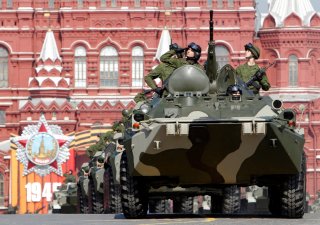Russia’s New Ceramic Armor Plating Could Be a Real Game-Changer
When used in composite body armor it can act as a crushing layer where it can be more effective against armor-piercing bullets and shells than steel.
Here's What You Need to Remember: Russia is not the only military power to be working on steel alternatives. The United Army Research Laboratory and the University of Buffalo have conducted laboratory experiments involved in restructuring microscopic materials to massively increase an ability to “absorb impact” and “dissipate energy.” The new material being used is a reconfigured variation of—Ultra High Molecular Weight Polyethylene—a plastic-like composite material known for its durability and toughness against extreme force such as hard-object penetration and explosive impact.
When one thinks of “armor” it likely evokes the concept of plates of heavy steel—as originally it was worn on the body. The most iconic would be the medieval armor worn by knights and other soldiers. However, in early the early twentieth-century the term “armor” came to be used to describe tanks and similar steel-protected vehicles. Yet today armor isn’t just steel—there are now composite materials that are lighter than steel have been developed and these have the added benefit of increased resistance to high velocity impacts.
This has been seen in combat helmets and personal body armor, where Kevlar, Twaron and other para-aramids utilize heat-resistant synthetic fibers, but another attempt has been in the form of ceramics. In fact, the early tests of ceramic armor for personnel were conducted during the First World War. British Army Major Neville Monroe Hopkins discovered that the ballistic properties of steel were enhanced by adding a thin layer of enamel. The concept was considered again during the Vietnam War to provide extra protection to U.S. Army helicopters, which frequently came under small arms fire.
Now the Russian military has announced that the Technodinamika Group—part of the state tech corporation Rostec —plans to complete the manufacturer’s trials of the unique ceramic armor for armored vehicles at the beginning of next year.
“The manufacturer’s trials are currently underway,” Technodinamika Group CEO Igor Nasenkov told TASS on Thursday.
Nasenkov added that the tests should be concluded with three to four months, with the goal to develop plates that would provide additional protection to the Russian military’s armor vehicles.
“Our product features such advantages as lightness and big resistance to various artillery and tank weapons,” explained Nasenkov.
The corundum ceramic armor plates were developed by Ufa Aggregate Production Association. Corundum ceramics is a super-hard material produced on the basis of aluminum oxide. It typically contains traces of iron, titanium, vanadium and chromium. Because of its hardness, it can scratch almost every other mineral and its commonly used as an abrasive in sandpaper.
Next year’s tests will determine how corundum ceramics can be applied to tanks, but Rostec has already announced that it would begin serial production of the high-strength ceramic armor plate for use in personal body armor as well as for ground, air and naval equipment.
When used in composite body armor it can act as a crushing layer where it can be more effective against armor-piercing bullets and shells than steel. When a bullet hits the ceramic armor, the core is deformed on the surface of the plate and is easily retained by the second layer of protection, which could include steel or polymer.
“The creation of ceramic armor is one of the most promising directions in the development of body armor,” Naskenko explained back in September. “It is lighter and smaller in size, but at the same time more dense in structure than armor steel. Plates made of corundum ceramics are capable of protecting not only personnel, but also air, land and sea equipment from armor-piercing bullets and shells. Currently, work is underway to prepare for the serial production of products that will be supplied to manufacturers of personal body armor and combat equipment.”
During tests at the Russian Scientific Research Institute of Steel earlier this year, ceramic plates were fired at with a 7.62x54mmR SVD “Dragunov” rifle at a speed of 805-832 meters per second. The armor plates were able to absorb the rounds. While much heavier ballistic rounds would be fired at the Russian tanks, the corundum ceramic plates would also be far thicker as well.
Another advantage for tanks and armored personnel carriers (APCs) that are protected with the corundum ceramic is that the material isn’t magnetic, which make it harder for magnetic mines to be placed on the tanks. Additionally, unlike steel armor, which is welded together, individual sections of the corundum ceramic could be replaced as a vehicle takes damage.
Russia is not the only military power to be working on steel alternatives. The United Army Research Laboratory and the University of Buffalo have conducted laboratory experiments involved in restructuring microscopic materials to massively increase an ability to “absorb impact” and “dissipate energy.” The new material being used is a reconfigured variation of—Ultra High Molecular Weight Polyethylene—a plastic-like composite material known for its durability and toughness against extreme force such as hard-object penetration and explosive impact.
Peter Suciu is a Michigan-based writer who has contributed to more than four dozen magazines, newspapers and websites. He is the author of several books on military headgear including A Gallery of Military Headdress, which is available on Amazon.com. This article first appeared last month and is being republished due to reader interest.
Image: Reuters

